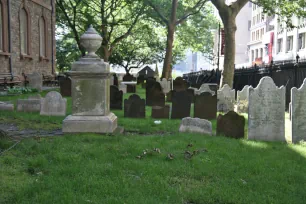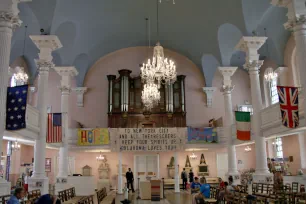St. Paul’s Chapel is the oldest church in Manhattan, and the only church remaining from the colonial era. Inside the church is an exhibit on the events of September 11, 2001, when the church was used as a shelter for rescue workers.

The St. Paul’s Chapel belongs to the parish of Trinity Church. As the fledgling city started to expand north in the eighteenth century, Trinity Church decided to build a church for the people living “uptown”.
Construction
Construction started in 1764 and the edifice was completed two years later, in 1766. It was built with stones quarried locally, from what is now the churchyard. The site chosen, near the Hudson River, was still an open field just north of the former defensive wall around Manhattan. The main entrance to the church faced west, towards the river, which at the time extended beyond the nearby WTC site.


There are no records of who designed the church, but it is thought that the architect was Thomas McBean, a student of James Gibbs. Gibbs designed the iconic St. Martin-in-the-Fields in London, which became a model for churches in the eighteenth century, including the St. Paul’s Chapel in Manhattan.
The imposing east portico along Broadway and the tower over the west portico, both part of the original design, were added later: the east portico was built in 1767-1768 and the bell tower was added in 1793-1794 by James Crommelin Lawrence.
Architecture
The church’s architecture is a prime example of Georgian Classical-Revival style. Gibbs’s influence is clearly visible throughout, from the massive neoclassical portico and use of alternating stones on the corners to the well-proportioned tower.
At the time of completion, the east portico of St. Paul’s Chapel was among the largest in the British Colonies of North America. In a niche on the portico’s pediment stands a statue of St. Paul. The statue looks like it’s made of stone, but it’s actually carved out of wood. The pediment rests on four fluted Ionic columns.
The tower rises from the west facade. It has a stepped design with a rectangular base and a shaft consisting of octagonal sections, surmounted by a replica of the Choragic Monument of Lysicrates in Athens and topped with a tall spire. The octagonal sections are decorated with Corinthian columns and urns. The large bell was founded in London and installed in 1797.
Sights



The monument against the east wall in the portico is the oldest public monument in New York built in honor of an American Revolutionary War hero. The monument, created by the Italian sculptor Jean-Jacques Caffieri, was installed here on April 3, 1789. It commemorates General Richard Montgomery, who died in 1775 during a failed attempt to capture Quebec City.
In the churchyard are several more monuments, as well as many tombstones from colonial times. The Actor’s Monument was erected in 1821 on behalf of the English actor Edmund Keane to commemorate his colleague and compatriot George Frederick Cooke. A more recent monument, installed here in September 2002, is the Bell of Hope, which is rung every year on September 11.
The bell was a present from London’s St. Mary-le-Bow, the sister church of the St. Paul’s Chapel.
The interior is mostly unchanged from the early eighteenth century, with cream painted walls and white Corinthian columns. The pulpit is painted white as well. The cut-glass chandeliers date from 1802. The organ was built two years later. The gilded decoration above the altar, a glory, was created by Pierre l’Enfant, the architect best known for his urban plan for the new capital, Washington D.C. For two years, during the time that New York City was the capital, George Washington worshiped at St. Paul’s, and you can still see his pew.
Due to its proximity to the WTC site (the twin towers were across the street), the church was used as a shelter and relief center for rescue workers in the aftermath of the 9/11 tragedy. The fence around the church was completely covered with flags, FDNY hats, T-shirts, photos and letters. A sample of these items are displayed inside the church. A memorial inside, covered with photos, letters and personal items, honors those killed in the attacks.
